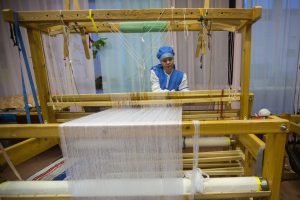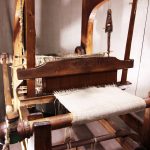
The days grow shorter. Have you noticed the shadows? We’re midway through the dark half of the year. To survive the coming winter, we need stories of heroes. The story we need the most is about you. What happens to you after “Once upon a time”? Let me share my interpretation of an ancient folktale and a modern ritual to help discover your heroic story.
I live in New England. It’s September. Imagine that you and I are sitting on my deck overlooking the meadow. We’ve just enjoyed a dinner of baked salmon with a bourbon glaze, a medley of roasted root vegetables, baked apples, and popovers drizzled with honey butter. The sun is sinking fast, brushing the horizon with warm coral, and cool gray. We watch the birds disappear into the trees, roosting for the night. There’s a chill in the air. We’re wearing old flannel shirts, fleecy vests and our hands are cupped around fat mugs of hot vanilla chai.
The autumnal equinox will occur later this month. We’re getting ready. How? By doing what I imagine my ancestors did. We’re telling inspiring stories of people who survived hardship and loss. Why? Because although the autumnal equinox is all about the harvest and the festivals it brings, the arrival of autumn also means… winter is coming. Winter, the season of hardship and loss.
Just look at the common names for the coming full moons. Keep in mind that the moons were named for the arrival of some visible feature of nature:
November – the frost moon
December – the cold moon
January – the wolf moon
February – the snow moon
To help us survive the hardship and loss looming on the road ahead, I’m going to tell you a story. It was told to me years ago by astrologer Caroline Casey. It’s an old folktale from eastern Mediterranean area or thereabouts.
Know at the outset that I’ve heard several versions of this story. The message is the same in all of them. Know, too, that I’ve taken literary license in my own retelling.
Nows close your eyes…just for a moment. Imagine you live in a world far away, in a time long ago. Sand is everywhere as are palm trees heavy with clusters of sweet, sticky dates. Life is good. But a west wind valued for its gentleness has brought vultures. Death is near.
Open your eyes.
Open your ears.
Open your heart. And listen.
Fatima the Spinner: My Take on the Ancient Folktale
Once there was, and twice there was not, a time when a girl’s freedom was held hostage, when the world around her was destroyed, and life seemed hopeless. And so it was for Fatima.
She grew up long, long ago, in a land far away. Her mother died when she was barely three years old, leaving Fatima and her father to rebuild their lives.
Fatima’s father was a spinner. He taught Fatima how to spin wool from sheep and fibers from plants. The result was strong, stout rope they sold in the marketplace.
He knew that had Fatima’s mother lived, she would want their daughter to know beauty. So he taught Fatima how to color the rope — madder root for red rope, walnut hulls for earthy brown, the leaves of woad for blue rope, and Persian berries for green.
Time passed. Fatima grew beautiful and strong. On her twelfth birthday, her father took from his neck the small gold charm his wife had given him years ago to keep him safe when on the water.
“Now then,” he continued, “prepare for a journey. Our rope is ready for buyers. This time, we’re going across the sea to a new market. Such colorful rope will bring a fine profit. And, if we’re lucky, we shall find a handsome and suitable man for you to marry.”
Keep in mind, that’s how the world was back then. Girls were married young and even when they became women, they were not trusted to make decisions. They were thought too ignorant, too delicate. Or, perhaps the men knew the women and girls were just as strong, just as smart, as they thought themselves to be. Perhaps the idea frightened them. Who can say?
Fatima and her father loaded their rope on the ship headed across the Mediterranean. She dreamed of what her life would be like if she, indeed, met and married a handsome man her age and they raised a happy family.
Perhaps the other merchants on the ship were dreaming, too, for they were all caught unaware when the ship slammed against a hidden rock and was ripped apart. All the cargo was lost. And all aboard drowned — all except Fatima.
Pulled in the currents, tossed by the waves, Fatima was thrown like a shroud onto a beach. For three days she lay there, unable to move, certain she would die.
To her continued misfortune, Fatima had washed up on the shore of a village where the slave trade flourished. Mean men, rough men, dragged her from the beach into the village square and onto the platform where human beings were sold. Fatima’s future was bleak at best. And she knew it. She thought of the charm her father had given her. She had sewn it inside her clothing for safe-keeping.
What Fatima didn’t know was that on that very day the strap on the sandal on the foot of a kind old man had broken, forcing him to pause by the slave block. While repairing his sandal, he saw Fatima. He had come to the village with just enough money to buy a lamb. But seeing Fatima, he knew he had to purchase her instead.
The old man exchanged his coins for the girl. He explained to Fatima that he was a weaver. He would take Fatima to his home, far up the coast. There, she would be a companion to his wife who was in poor health and lonely since they were never blessed with children. He promised that in three years time he would give Fatima her freedom. With a heavy and grateful heart, Fatima resigned herself to her fate.
As luck would have it, when they arrived at the old man’s village, they found most of it burned to the ground. The old man’s wife was still alive, but very weak. The old man panicked. He needed to care for his wife and he needed to weave cloth to sell. With the loom in ashes, he needed to build a new one.
 Fatima took good care of the old woman. When she was asleep, Fatima helped the old man build the new loom. Day by day, the old woman regained her health. She taught Fatima songs about strength for wrapping the warp and songs about love for weaving the weft. Fatima caught on quickly and soon mastered the art of weaving good, stout cloth.
Fatima took good care of the old woman. When she was asleep, Fatima helped the old man build the new loom. Day by day, the old woman regained her health. She taught Fatima songs about strength for wrapping the warp and songs about love for weaving the weft. Fatima caught on quickly and soon mastered the art of weaving good, stout cloth.
Time passed. Surely Fatima’s parents had answered her prayers, for Fatima bloomed in the village. The old couple loved and cared for Fatima as though she were their own. In no time, she had increased their production of cloth. Its sale brought modest prosperity to the couple.
True to his word, when three years had passed, the old couple gave Fatima her freedom. She decided to stay with them and make the village her home.
Three more years passed. Much as Fatima treasured her comfortable life in the village, she always wondered what life was like in other villages. That’s what her father wanted to show her that fateful day they left their own home.
So one day, Fatima ventured farther from the village than she’d ever gone before. From where she stood at the top of a cliff, she spotted an outcropping of berries, the likes of which she’d never seen. Perhaps she could use them to color the stout cloth she had just cut from the loom.
She climbed down the cliffs to the beach. That’s when she saw the pirates. As luck — terrible luck — would have it, that’s when the pirates saw Fatima. They’d been hiding in a cove just beyond the berries.
 Fatima ran back toward the cliffs but the pirates ran faster. They couldn’t risk having her tell anyone that they were hiding in the cove or that they had just buried a chest full of gold under the berry bush. In no time at all, they set sail for the open seas, Fatima on board.
Fatima ran back toward the cliffs but the pirates ran faster. They couldn’t risk having her tell anyone that they were hiding in the cove or that they had just buried a chest full of gold under the berry bush. In no time at all, they set sail for the open seas, Fatima on board.
When it was clear she could not escape, Fatima resigned herself to her fate.
For the next six years, Fatima lived onboard with the pirates. Alas, I don’t have time to recount all of her wild and wondrous adventures for there were many. I must, however, share three things:
- With every port of call Fatima met new people, saw new clothes, ate new food, heard new music, discovered new plants, learned new stories.
- The pirates insisted Fatima earn her keep. They taught her how to make the tall masts that hold the ship’s sails.
- From the very first day, the pirates treated Fatima with respect, perhaps because of the charm she wore around her neck: a gold trident, symbol of Poseidon, God of the Ocean.

Still, every night when the sky was clear and salted with stars, Fatima looked up and talked to the mother bear and her cub. Would she ever have the happy life she dreamed of long ago?
As luck would have it, one day while the ship was off the coast of China, a terrible storm arose. Monstrous waves crashed onto the deck. Wind whipped the sails to shreds. Lightning struck the mast, sending it crashing onto the deck. In minutes, the ship sank and all aboard were drowned. All except Fatima.
Stronger than she’d ever been and angry that fate had dealt her another blow, Fatima swam toward the shore.
What she didn’t know was that in that part of China there was a prophecy. It had long been foretold that one day a magical woman would arise from the sea and she would bear knowledge of great value to the Emperor.
Not knowing when she would arrive, the Emperor sent guards to patrol the beach every day. Of course, the beach was long, making it impossible for the guards to see all of the beach all of the time.
But as luck would have it, the guards were in the perfect spot at precisely the moment Fatima came to shore. There she was, rising from the foam, shaking her fists at the heavens and shouting, “Why me? Why have you done this to me again? Why?”
The Emperor’s guards rushed toward her. This time, unlike the slave traders, unlike the pirates, the guards knelt down before her.
“Our Emperor has been waiting for you. You must come with us.”
Fatima could see that if they meant her harm, she was outnumbered. If they spoke truthfully, she had nothing to lose by going with them. “Very well,” she said. And off they went.
The Emperor, a distinguished man her father’s age, held a grand feast in her honor. At the appropriate moment, he stood and said, “If you are truly the one whose arrival has been foretold, you will accomplish what has, until now, been impossible.”
And what if I can’t, Fatima wondered. A feeling of dread shot up her spine. Could her world be on the brink of disaster again? “What would you have me do?” she asked and fingered the trident at the base of her throat.
In a most authoritative voice, the Emperor said, “Build me a tent.”
“A tent?”
“Yes. I have heard of such things but have never seen one. If you can build me a tent, I shall grant you any wish.”
“Very well,” Fatima said. “First, I will need strong rope in many colors.”
The Emperor frowned, “I cannot give you what you need.”
Fatima remembered her years with her father, learning to spin wool and plant fibers into strong rope, coloring them with madder root for red, walnut hulls for earthy brown, the leaves of woad for blue, and Persian berries for green. Could the Emperor get those for her? Yes. And so he did. And so, Fatima did as she had been taught those many years ago, and spun giant coils of strong, colorful rope.
To the Emperor, she said, “Now I need stout cloth.”
The Emperor answered, “I cannot give you what you need.”
Fatima remembered her years living with the kindly old couple, the weavers. Could the Emperor have a giant loom build? Could he have the villagers gather flax? Yes. And so he did. And so, Fatima did as she had been taught those many years ago, and wove mountains of stout cloth.
Now to the Emperor, Fatima said, “I need poles, taller than the tallest tree.”
The Emperor answered, “I cannot give you what you need.”
Fatima remembered her years living with the pirates, learning how to fasten several trees together at intervals to create the masts needed for the ship. To the Emperor she said, “Then give me strong men with axes and lead me to an old forest.”
The Emperor complied. Several weeks later, Fatima assembled the trees, the stout cloth, and the strong rope. She thought about all the exotic ports of call she’d seen in her years with the pirates. And from the sum of her memories and her imagination, she created a massive, sturdy, colorful tent.
 “Magnificent!” cried the Emperor. “You are truly a magic woman! And I am an emperor who is true to his word. What do you wish for? I will grant it with pleasure.”
“Magnificent!” cried the Emperor. “You are truly a magic woman! And I am an emperor who is true to his word. What do you wish for? I will grant it with pleasure.”
There was no reason for tears and yet Fatima’s eyes filled. “Thank you for your kindness,” she said. “But my wish is to have my mother and father with me again. And I know you cannot give me what I need.”
The Emperor stood silent. Then he instructed four of his five sons, all grown men, to bring their wives and children and join him in the center of the grand tent. He ordered food and drink and silk cushions for sitting. When all of his sons and their families were comfortable, the Emperor turned to Fatima. “Tell us of your mother. Tell us of your father.”
Fatima complied. Telling the first few stories brought tears. Eventually, the stories she told made her laugh at the memories. Her laughter made the others laugh, too. By the time the Moon had risen, Fatima had given life to her memories. She thanked the Emperor and added, “You are a true magic man, for you have given me back my parents, just as I had wished. When I leave in the morning, it will be with a joyful heart.”
“Don’t leave,” the Emperor said. “Make your home here.” My son will show you the city and introduce you to the people.” The Emperor called to his fifth son, a handsome man Fatima’s age, the only son without a wife. With great pride, he introduced her to the city and its people. Fatima readily engaged with the women.
Time passed. And as luck would have it, Fatima and the Emperor’s son fell in love, got married, and raised a family.
In the original version of this folktale, at least the original as it was told to me, Fatima marries the Emperor. In my retelling, I chose a man her own age. I changed something else, too. You didn’t hear about it in the main story. I’ll tell you now.
You see, when the Emperor’s son proposed marriage, saying how much he wanted to have a family with Fatima, she reminded him of the knowledge she had gained in the many ports of call she had visited during her time with the pirates. She learned more than how to find her way by the stars, or how to read fortunes with cowrie shells. She learned the power of herbs and plants, particularly those to empty her womb should she be in distress. If she married the Emperor’s son and stayed in the city, she would share her knowledge with the women — for they should have the same choice.
Fatima assured the Emperor’s son that she did want to marry him and have children, for she had been lonely for many years and longed for a family of her own. But she, and she alone, would have control over her body. If he could accept that, she would be happy to call him husband.
The wedding was an elaborate affair. Everyone from royal to peasant attended. In the years that followed, Fatima held regular gatherings with the women. She taught them how to follow the stars. She taught them songs for strength and songs for love. She taught them about plants and herbs for coloring cloth…and more. And she told them her story, how each adversity taught her something she would later use to create her ultimate happiness.
Yes, Fatima, her husband, and their children did live happily ever after.
The Power of Your Warp and Weft
About 15 years ago, my friend Liz Aleshire and I spent a weekend at the home of our mutual friend and fellow writer, Paula Scardamalia. Paula was also a professional weaver. She has since retired herself from the physical warp and weft and has put her largest loom up for sale. But, at that time, her studio vibrated with color from the cones of chenille thread hanging on the wall.
Paula had just published her first book, Weaving a Woman’s Life: Spiritual Lessons from the Loom. She wanted to develop a hands-on workshop that would enable women to physically experience one of the most memorable lessons from the book — the power of the warp and weft. She asked Liz and me to beta test the workshop. In a flash, we packed our bags–and fresh notebooks — and drove to upstate New York to the foothills of the Catskills.
After a delicious lunch, we gathered in the family room where Paula explained the purpose of the workshop. She began with a guided meditation designed to put us in touch with childhood memories.
Notebooks in hand, we followed instructions and listed aspects of our childhood over which we had no control. Liz and I both listed:
- Family finances
- Family religion
- Family politics
- Siblings
- Neighborhood
- Education
I added:
- Rules about pets
- My dad’s military service
- My dad’s discipline
- My mother’s early death
- Threats of being placed in foster care
Liz added her parents’ anger towards each other, and her mother’s mental illness.
Paula instructed us to assign a color to each of the items on the list. For those that made me feel sad or angry or resentful, I chose black, brown, and gray. I assumed our family’s finances were okay so I chose green. Liz’s colors were similar.
We talked about how each item on the list had affected us as children and to what degree, if any, the item still influenced us as adults.
Imagine yourself doing this part of the exercise. Even if you write down only three items and assign colors, do it. It will help you understand how profound the workshop proved to be.
 For the next step, Paula gave each of us a basket and a pair of scissors. She told us to bring those items and our list, go into her studio, and cut a yard-and-a-half of each color on our list.
For the next step, Paula gave each of us a basket and a pair of scissors. She told us to bring those items and our list, go into her studio, and cut a yard-and-a-half of each color on our list.
You need to understand, Paula had at least six shades of each color — at least six. So Liz and I spent a good thirty minutes selecting our yarn.
When we returned to the family room, Paula gave each of us a piece of foam core, about 12×17, and a wooden ruler.
According to her instructions, we took the yarn for the first item on our list, looped it around the foam core, top to bottom and tied a knot. We continued to wind the yarn, keeping each turn snug against the one before.
Along the way, whenever we reached the end of a piece of yarn, we tied on the color we had chosen for the second item on our list. First, we had to make a decision. Tying on a new color meant there would be a knot. Did we care if the knot was visible on the front of our piece? Or, did we want to adjust the length so we could hide the knot in the back of the work? Each time we added a new piece of yarn, we had to make that decision again.
Once Liz and I had wrapped all of the yarn representing aspects of our childhood over which we had no control, we assessed the finished look. Neither of us were pleased. Mine felt heavy, depressing, oppressive, something to be endured. Liz’s thoughts were similar.
Paula guided us on another visualization. This time, we were young adults, on our own. We carried the image of our independence as many years forward as we wanted.
We made a new list: aspects of life over which we did have control. My list included:
- Move to New England
- Get a divorce
- Attend writers’ conferences
- Teach at writer’ conferences
- Write a book
- Take belly dance lessons
- Buy a car I wanted
Liz’s list included teaching at writers’ conferences, too. Her list also included learning to quilt, getting involved in local politics, and keeping her Christmas tree up all year.
 As before, we talked about the significance of each item and why it was important enough to include on the list. As before, we assigned a color to each item, went into Paula’s studio, and cut yarn. When we returned, our baskets overflowed with turquoise, teal, cranberry, lemon, lavender, cobalt, purple, emerald, lime, coral, cream, silver and gold.
As before, we talked about the significance of each item and why it was important enough to include on the list. As before, we assigned a color to each item, went into Paula’s studio, and cut yarn. When we returned, our baskets overflowed with turquoise, teal, cranberry, lemon, lavender, cobalt, purple, emerald, lime, coral, cream, silver and gold.
Starting at the bottom of the foamcore, we slid the wooden ruler over and under the warp threads. Then we tilted the ruler on its side, creating a shed. That gave us space to insert the yarns we had chosen for the items on our second list. This time, we wove right to left, left to right, back and forth, all the way up the loom, tying on new colors as needed.
This time, we created a pattern. The design was up to us. We could weave over and under 2 warp threads, or over 2 and under 5, or 7, whatever combination we chose. We could change the pattern mid-stream if we wanted to. The choice was always ours, including whether or not to let the knots show.
 I finished my weft. Liz finished hers. We both liked the end results. A lot! Paula, who has an MFA in fabric arts, explained the effect we wanted to achieve with our colorful weft would never happen without the foundation, and sometimes darker threads, of a strong, tight warp. My turquoise wouldn’t look nearly as vibrant as it did if not for the black and dark brown of the warp beneath it. Same for the orange Liz used. It popped like her neon earrings because of the gray and black warp beneath it.
I finished my weft. Liz finished hers. We both liked the end results. A lot! Paula, who has an MFA in fabric arts, explained the effect we wanted to achieve with our colorful weft would never happen without the foundation, and sometimes darker threads, of a strong, tight warp. My turquoise wouldn’t look nearly as vibrant as it did if not for the black and dark brown of the warp beneath it. Same for the orange Liz used. It popped like her neon earrings because of the gray and black warp beneath it.
I liked the calm look achieved by hiding my knots. Liz liked her visible knots; she called them outlaws.
We talked for hours about the adversities of our youth and about how meeting them gave us the tools, the strength, and the wisdom that prepared us to create our happiness as adults. I suddenly realized I had been on my own version of Fatima’s journey. To this day, I remember the power of that ah-ha moment.
My hope is that by learning Fatima’s story and by doing your own version of Paula’s warp-and-weft workshop, you’ll recognize how the losses, obstacles, and reversals of fortune in your life have given you tools unique to you. Because, some day, you may find yourself faced with an opportunity to create your ultimate happiness and all you’ll have to do is build a tent.
~ ~ ~
Weaving a Woman’s Life
My thanks to Paula for letting me share her workshop with you. The book that inspired it, Weaving a Woman’s Life: Spiritual Lessons from the Loom by Paula Chaffee Scardamalia, is available on Amazon or on her website: DiviningTheMuse.com. For a signed copy, email Paula@DiviningTheMuse.com. Paula’s new book, Enchanting Creativity: With Fairy Tales, Dreams, Rituals and Journals, is due out in Spring 2022 from Schiffer Books. It offers a new way to look at the creative process and path, using the familiar fairy tale of Sleeping Beauty as a metaphor, and the tools of dreams, rituals and journals as a way to stay receptively inspired and actively productive, restoring that spark of magical enchantment to the creative life.

